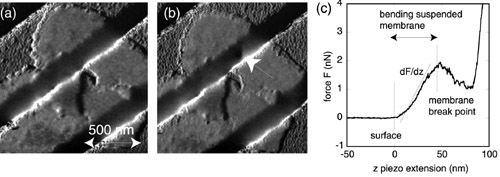1Materials Science Laboratory, 2University of Oxford
Using the atomic force microscopy (AFM), we have studied the mechanics
of purple membrane (PM) suspended over nanostructures. By doing this we
could evaluate the properties of the biological membrane free from interaction
with the substrate. Biological membranes containing lipids and proteins
are important components of bio-nanostructures with many potential applications,
e.g. single-molecule biosensors, and reliable measurements of their mechanical
properties are essential.
PMs of Halobacterium salinarium strain S9 were adsorbed on a Si substrate with nano-trenches fabricated
using a photolithographic technique. After locating the suspended PM using
the AFM in imaging mode, force-displacement measurements were performed.
Figure shows AFM images of PM suspended over nano-trenches (a) before and
(b) after indentation and (c) the force-displacement curve measured during
indentation. The indentation mark left by the AFM tip can be clearly seen
in (b) as indicated by the arrow. As the force is increased the suspended
membrane was stretched and finally punctured. The force-displacement curve
during membrane stretching reflects its mechanical property directly. To
evaluate the surface tension, a simple theoretical model was made, and
theoretical force curves were obtained to simulate the experimental force
curves. From the best-fit curve, the elastic modulus of PM was estimated
to be 8±1 MPa [1].
We have demonstrated that AFM measurements provide a very good approach
to evaluate the mechanics of biological membranes in their native conditions.
Proteins in the suspended potion of the membrane are not affected by the
substrate and are more likely to function as they would in vivo. The next stage of this project is to measure changes in properties in
response to an external stimulus such as mechanical stimulus, light irradiation,
and chemical binding.
This research was supported in part by the Strategic International
Cooperative Program, Japan Science and Technology Agency (JST).
[1] Ari M. Siitonen, et al., Appl. Surf. Sci., in press.
 |
||
|